Some pr0n for your viewing pleasure.
This unpressed, unmolded, unfinished chip is only slightly larger than a standard finished 39mm
THC:
... but it's official casino weight!
Sorry I don't have a higher-resolution scale. It's somewhere between the high end of 14g and the low end of 15g; the scale would switch between 14 and 15 at different moments.
Here's a super close-up, and I'll put a few more in thumbnails. Sorry I'm a lousy photographer. Happy to take more if any of you chip nerds want a better view of something specific.
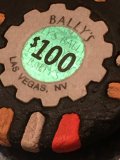
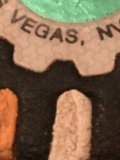
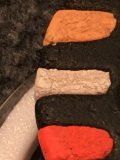
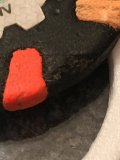
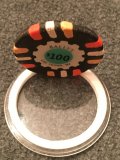
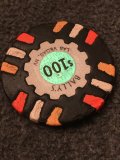
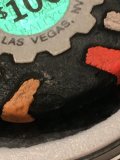
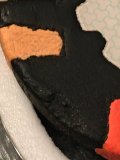
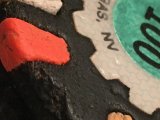
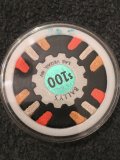
Just like the seller said, the chip is solid and firm; you can knock it on the table and it gives a satisfying thump. I'm still gonna treat it with kid gloves, of course. It has a nice heft to it, giving the impression of a slugged chip. But the chip IS the slug! And slug is a good word for it based on how it looks and feels; the lack of edge mold debossing and lack of crosshatched molded surface texture are really striking when you hold it in your hand and compare it to a normal
THC. The texture is smooth where the chip surface is intact; obviously the transition from the base to a spot has a bump/depression where the two pieces of clay meet. The spots don't seem to be in any danger of falling out; they're firmly in place, and I suspect they're melted together with the base chip further below the surface where you can't really see it.
The inlay is
somewhat pressed into the surface of the base chip. In fact, on one of the two sides, the inlay is
recessed below the chip surface on one edge while at the same time that same inlay is
raised above the chip surface on the opposite edge of the inlay. It's as if someone pressed the inlay into the chip with their thumb, and came down heavier on one side of the inlay than the other. The inlay on the opposite side of the chip is more evenly pressed into the chip surface. But in both cases, it's completely unlike what you get with a fully pressed chip. You can easily feel the edge of the inlay all the way around; it's not smooth, seamless, and flush with the chip surface at all.
And the inlay is amazing! It's shaped, of course, and I really like the gear shape. There's the honeycomb pattern around the outside, and the Bally's hologram in the center is just
intense when the light catches it. The inlay surface is super smooth, slick even.
And finally, here's a family picture with a few of my other favorite chips.











